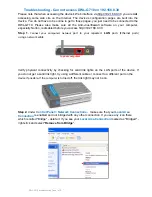
710
Configuring IP Multicast Routing
Configuring Advanced PIM Features
Troubleshooting PIMv1 and PIMv2 Interoperability Problems
When debugging interoperability problems between PIMv1 and PIMv2, check these in the order shown:
1.
Verify RP mapping with the
show ip pim rp-hash
privileged EXEC command, making sure that all systems agree on
the same RP for the same group.
2.
Verify interoperability between different versions of DRs and RPs. Make sure the RPs are interacting with the DRs
properly (by responding with register-stops and forwarding decapsulated data packets from registers).
Configuring Advanced PIM Features
This section includes the following topics:
Delaying the Use of PIM Shortest-Path Tree, page 710
(optional)
Modifying the PIM Router-Query Message Interval, page 712
(optional)
Delaying the Use of PIM Shortest-Path Tree
The change from shared to source tree happens when the first data packet arrives at the last-hop router (Router C in
in the
Information About PIM Shared Tree and Source Tree, page 684
). This change occurs
because the
ip pim spt-threshold
global configuration command controls that timing.
The shortest-path tree requires more memory than the shared tree but reduces delay. You might want to postpone its
use. Instead of allowing the leaf router to immediately move to the shortest-path tree, you can specify that the traffic
must first reach a threshold.
You can configure when a PIM leaf router should join the shortest-path tree for a specified group. If a source sends at a
rate greater than or equal to the specified kbps rate, the multilayer switch triggers a PIM join message toward the source
to construct a source tree (shortest-path tree). If the traffic rate from the source drops below the threshold value, the
leaf router switches back to the shared tree and sends a prune message toward the source.
You can specify to which groups the shortest-path tree threshold applies by using a group list (a standard access list). If
a value of 0 is specified or if the group list is not used, the threshold applies to all groups.
This procedure is optional.
BEFORE YOU BEGIN
Review the
Information About PIM Shared Tree and Source Tree, page 684
.
Summary of Contents for IE 4000
Page 12: ...8 Configuration Overview Default Settings After Initial Switch Configuration ...
Page 52: ...48 Configuring Interfaces Monitoring and Maintaining the Interfaces ...
Page 108: ...104 Configuring Switch Clusters Additional References ...
Page 128: ...124 Performing Switch Administration Additional References ...
Page 130: ...126 Configuring PTP ...
Page 140: ...136 Configuring CIP Additional References ...
Page 146: ...142 Configuring SDM Templates Configuration Examples for Configuring SDM Templates ...
Page 192: ...188 Configuring Switch Based Authentication Additional References ...
Page 244: ...240 Configuring IEEE 802 1x Port Based Authentication Additional References ...
Page 298: ...294 Configuring VLANs Additional References ...
Page 336: ...332 Configuring STP Additional References ...
Page 408: ...404 Configuring DHCP Additional References ...
Page 450: ...446 Configuring IGMP Snooping and MVR Additional References ...
Page 490: ...486 Configuring SPAN and RSPAN Additional References ...
Page 502: ...498 Configuring Layer 2 NAT ...
Page 770: ...766 Configuring IPv6 MLD Snooping Related Documents ...
Page 930: ...926 Configuring IP Unicast Routing Related Documents ...
Page 976: ...972 Configuring Cisco IOS IP SLAs Operations Additional References ...
Page 978: ...974 Dying Gasp ...
Page 990: ...986 Configuring Enhanced Object Tracking Monitoring Enhanced Object Tracking ...
Page 994: ...990 Configuring MODBUS TCP Displaying MODBUS TCP Information ...
Page 996: ...992 Ethernet CFM ...
Page 1066: ...1062 Using an SD Card SD Card Alarms ...
















































